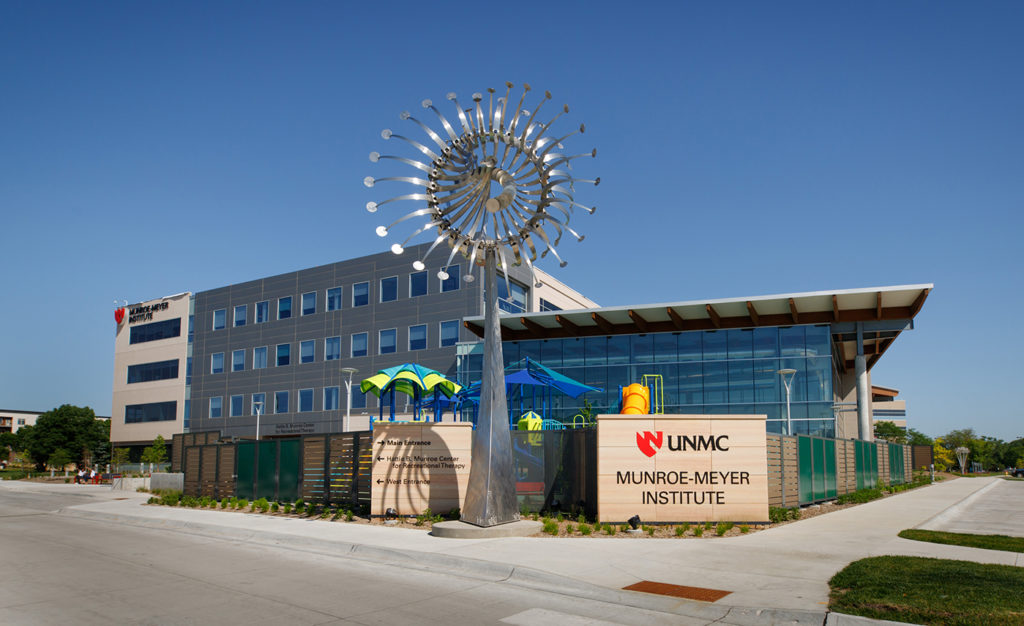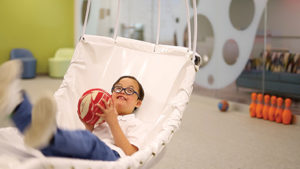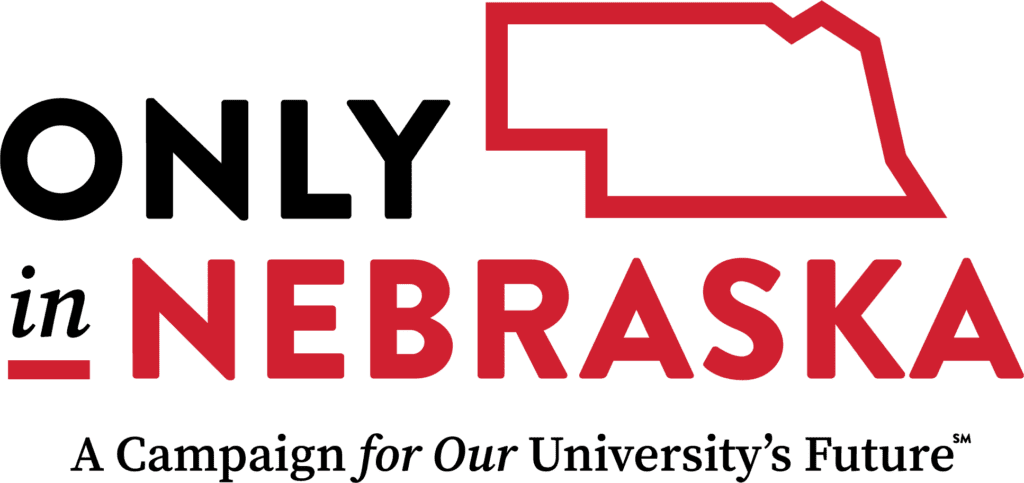A New Home for Treatments, Therapies and Joy: Munroe-Meyer Institute Provides Hope for Families

Christine Tran wasn’t certain how her son Joseph, 7, would respond to seeing the new 215,882-square-foot, state-of-the-art Munroe-Meyer Institute (MMI) building for the first time.
For more than five years, the familiar yellow canopy on the campus of the University of Nebraska Medical Center had signaled to Joseph his arrival at MMI. Seeing that yellow awning, Tran said, always gave Joseph a boost of energy.

“This place is truly amazing. Joseph’s eyes lit up when he saw that playground,” Tran said of the new facility. “And the size provides so many possibilities for the growth of programs into adulthood. MMI has been an important part of his life. We hope we never have to stop coming here.”
The environment of the facility appeals to clients across the lifespan and their families, where children, teens and adults can feel like they belong and can be successful.
There is a lot for individuals with intellectual and developmental disabilities and their families to absorb the first time they visit the new MMI, adjacent to the University of Nebraska at Omaha’s Scott Campus. From Nancy’s Place — the aquatic center — to Aspen’s Playground to the Holland Foundation Early Intervention Wing, the new MMI building is more than double the size of its former home of more than 60 years. It affords world-class providers more space for teaching, research, clinical and community engagement, as well as the accessibility individuals with intellectual and developmental disabilities require.
Early intervention for autism spectrum disorders is essential for developing long-term skills and outcomes. The Holland Foundation Early Intervention Wing encompasses nearly half of the new building’s second level and includes six classrooms and 35 treatment rooms. The Maker Space provides room for tools needed by MMI staff to create nearly any assistive device, such as orthotics, to assist in the performance of daily activities by MMI clients. Being located near the University of Nebraska’s Peter Kiewit Institute allows MMI faculty to collaborate with engineering students and faculty on new technologies that could lead to innovative treatments and therapies.
Researchers work side by side with clinicians and families in the Sensorimotor Lab to identify ways to improve the function and fitness of individuals with sensorimotor challenges, such as cerebral palsy. The lab allows for the rapid identification of key ingredients for expanding an individual’s ability to participate in engaging activities and leads to the availability of cutting-edge services for MMI clients. Its proximity to a nearby biking and walking trail allows for additional recreational and physical therapy options for clients.
And for clients and their families, the location offers an abundance of convenient and accessible parking.
EXCEEDING EXPECTATIONS
Familiar surroundings are a comfort to many with intellectual and development disabilities. So, when MMI announced that it would be moving from its former home, not everyone shared in the excitement.
Denise Gehringer has been intimately involved with MMI for years. Her son, Jake, 25, has been attending programs at MMI since he was 2. Another son, James Gehringer, Ph.D., is a research assistant professor in the department of physical therapy who oversees the new Virtual and Augmented Reality Lab. The lab brings together researchers and clinicians to create new computer programs that immerse clients into virtual environments and allow them to acquire new skills while having fun.
As the former president of the MMI Board of Directors, Denise Gehringer was excited about the nearly $91 million project and its possibilities for new and expanded programs. Jake, however, was hesitant about the move.
“Jake was a little irritated,” she said. “He wasn’t ready to leave. We were all a little sentimental about leaving a place that we had been a part of for so long. He doesn’t feel that way anymore. Jake has a little more pep in his step now.”
She said the new building exceeded all expectations. “It’s very welcoming and friendly. You get pulled right in.”
Bob and Vicky Vandervort’s son Michael, 34, was born with a rare condition that requires him to use a wheelchair and limits his ability to communicate. The couple recalled how Michael, then 10, cried after his first day at Camp Munroe, a recreational day camp program for children and adolescents with disabilities established in 1982 and funded by the Hattie B. Munroe Foundation. While they considered not finishing the week of camp, the Vandervorts soon realized that Michael wept because he did not want to leave. He was having so much fun, they said.
“Michael looks forward to going to MMI. Outside of family, it’s the number one thing that Michael loves,” Bob Vandervort said. “The activities provide him with a level of independence from us.”
“The pool area is unbelievable,” Vicky Vandervort said. “I had no idea it was going to be that nice. It’s Michael’s favorite thing to do.”
FULFILLING THE MISSION
Károly Mirnics, M.D., Ph.D., director of MMI, said the transition is less about the building and more about providing MMI’s innovative and creative staff the space to establish new programs, to expand existing programs and to fulfill MMI’s mission to be world leaders in transforming the lives of all individuals with disabilities and complex medical conditions.
“Our amazing new building is a vessel for services,” Mirnics said. “I am in awe of the possibilities, but also aware of the expectations placed upon us.
“It took a community to make this happen, and I am very proud to be part of this community, which cares so deeply about the people and families MMI serves. Most importantly, our new home allows us to provide the best, most comprehensive, supremely integrated family-centric services in the world.”
Philanthropic support was crucial to the new building’s transformation. Private gifts to the University of Nebraska Foundation, coupled with $10 million in state bonds, provided funding for the project.
Jennifer Read and her family relocated from North Platte, Nebraska, seven years ago to access services at MMI. Her son Tucker, 11, had shown signs of being on the autism spectrum, but services offered through his school in North Platte were limited.
“I did some research and knew we had to get him here,” Read said. “He loves coming to camp. We see a completely different Tucker on his days at MMI.”
Read was especially excited about the new programs now available through MMI.
The Caring for Champions Program was established to provide equitable access to quality health care, education and services to individuals with intellectual and development disabilities. Providers from UNMC’s College of Dentistry, Truhlsen Eye Institute and MMI’s nutrition services provide access to vision, oral health and wellness services that are tailored to the patients’ unique situations.
“People on the spectrum often struggle to get services like eye and dental care,” Read said. “Having providers who know how to work with people on the spectrum helps to make the experience more pleasant. There are so many exciting things going on here.”
DELIVERING ON THE PROMISE
While the new facility received rave reviews, parents noted that the building would mean little without the staff who deliver the services.
“It’s a world-class facility, but it’s the people who make the difference,” Bob Vandervort said. “This staff is so creative and imaginative … to turn them loose in a facility like this, they will take things to a whole new level.”
Noah Farho, a senior biology major at UNO, is one of those people. He began volunteering at MMI in 2015 to obtain service hours for school but fell in love with the program. He has been a member of the recreation therapy staff since 2017. It’s the joy he gets from the relationships that he has built with the program’s participants and staff that keeps him coming back.
Farho said he was “blown away” by the size and features of the new location. However, being able to experience his clients’ reactions to the pool and playground for the first time has been his favorite part of the new facility.
“It’s wonderful to be able to provide our program participants with the type of building and the features they deserve,” Farho said. “The new facility expands the number and the quality of programs we are able to provide.”
In the end, what happens inside the building is what matters most.
“I always worry about leaving him (Tucker) places,” Read said, “but not here. Tucker loves coming here. He feels comfortable and safe. We have people here who know him and love him.”
Tran agreed.
“It’s like dropping him (Joseph) off at his grandparents’ house. We don’t have to worry. We know that he’s going to be OK,” she said. “We are so grateful to have something like this in our community that celebrates our children.”





